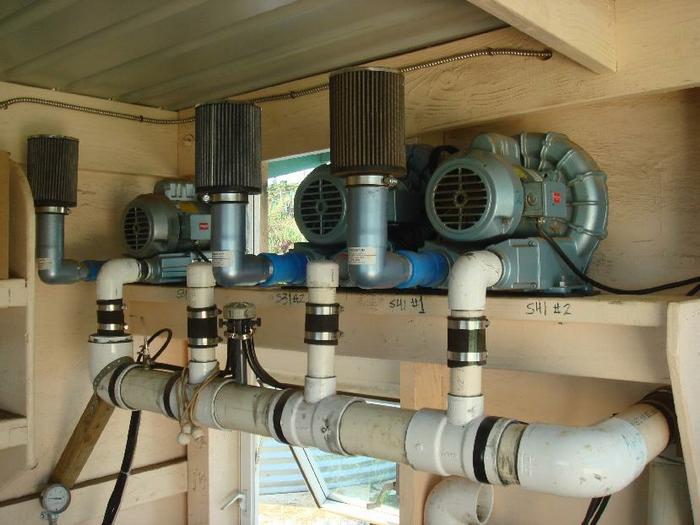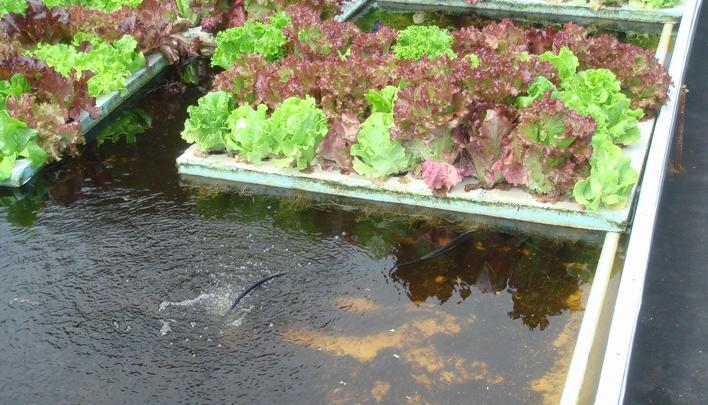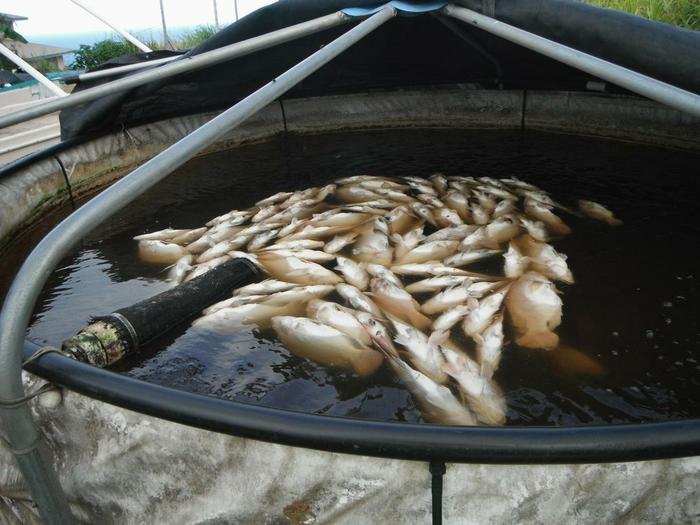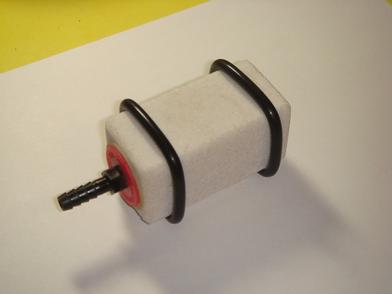Aeration, Air Pumps, Blowers, And Airstones
Aeration can be done in all kinds of ways using all kinds of equipment and methods: airlift pumps, water sprays, paddlewheels, rotors, blowers, compressors, etc. They all use MORE electricity to create the same level of DO (dissolved oxygen) in the water than medium pore airstones connected to regenerative blowers do. You can experiment with these if you want and have the time and money. We never had extra time or money, so we just use the airstones and regenerative blowers. They work wonderfully!
The reason we use the equipment and methods in the following paragraphs is that they are the MOST ENERGY-EFFICIENT for the depth of water we have. You will have your air generation devices on 24/7 for years once you start up (a power outage can kill or stress fish, more on this later), and they need to not only be dependable, but as energy-efficient as possible. Any inefficiency will multiply many times over and show up in your bottom line at the end of each year.
(Below) The result of an employee unconsciously turning off an air valve without thinking. There was 300 pounds of dead fish in this tank when we discovered it Monday morning, worth $1,500 at the retail price we sell them for at the farm.
Aeration in the smaller systems (TableTop Systems, Micro Systems, and Family Systems) is created by an energy-efficient and long-lasting air pump connected by Schedule 40 white PVC and food-grade vinyl tubing to medium pore airstones which are near the bottom of the tanks and troughs. Air pumps are rated at a certain CFM (cubic feet per minute) at a certain depth of water (H2O), which depth is measured in inches. Air pumps are generally not big enough to power the larger systems, unless you buy several of them; and then, a single large regenerative blower (next!) is more dependable and much more energy-efficient. When you buy an air pump, consider the warranty period: if it’s six months, that’s probably a cheap pump. If it’s three years, it’s probably a good pump.
Aeration in the larger commercial systems is created by a regenerative blower connected by Schedule 40 white PVC pipe and food-grade vinyl tubing to medium pore airstones which are near the bottom of the tanks and troughs. Blowers are rated at a certain CFM (cubic feet per minute) at a certain depth of water (H2O), which depth is measured in inches. If you have a big enough system, it is a good idea to have two smaller blowers rather than a single big one; this way, you have some built-in backup.
(Below) This is an Aquatic EcoSystems AS8L “medium pore” airstone. Not cheap at around $6 each, but we’ve run these for 8 years straight without clogging. “Cheap” stones often clog in 3 weeks or less; which kind will you buy?
Here’s the reason the airstones are positioned at or near the bottom: It is easier to push air out of an airstone that is in shallow water than out of one that is in deep water, and it makes lots of bubbles. However, you don’t get as much oxygen into the water as you do if the airstone is deeper. When the airstone is deeper the bubbles come out of the airstone smaller because of the higher water pressure down there (and they have more surface area), and travel further to the surface, with the surrounding water absorbing oxygen from the bubble all the way to the top of the tank where it bursts at the surface. Less fuss, but much more DO into the tank water.
So we have our airstones 2″ off the bottom of the tank, which gives us a high DO with minimum electrical usage. FWIW, even though the UVI course we took taught us to clean our airstones, we’ve never cleaned our airstones in 8 years of operation. We find that every once in a great while, one simply quits, and diagnosing or cleaning it doesn’t help; so we throw it away. We’ve lost a grand total of four $10 airstones this way in eight years.
(Below) This is 3 Sweetwater regenerative blowers on a 3″ PVC manifold that runs 250 feet to the other end of the farm. We can take air off that manifold anywhere we want, and the blowers are all located in a dry, well-ventilated space.
On the off chance that you find that your airstones do get clogged with aquaponics system crud, you can scrub them with a wire brush, then dunk them in a Clorox or hydrogen peroxide solution to clean them off, then dry them off in hot sun for a couple of days. To do this, you need to either take just a few off at a time, plug the tubing they were attached to, and clean them; or you need a spare set of airstones so you can rotate them in while the others are cleaned.
WARNING! DON’T put them back in the system without making absolutely sure they are free of Clorox. If they still have bleach down in their pores, the bleach will just transfer into the system water when you hook them back up and may stress and/or kill your fish and plants.
WARNING #2! This bit about your airstones not clogging ONLY applies to the good (good, not cheap) Sweetwater medium pore airstones from Aquatic EcoSystems/Pentair Aquatics. We use their AS15S and AS8L airstones. We’ve tried many varieties of cheap airstones; we find they clog easily in a short time, and cleaning them doesn’t help.
Our blowers are Sweetwater S31’s and S41’s and run 24/7. They are the most expensive blowers on the market, but they run and run and run; this makes them cheap. They say you should replace the bearings (about $50) after three years of continuous operation, but we haven’t needed to. Our blowers have been running for eight years continuously without changing the bearings. One blower needed a new capacitor ($50) about three years ago.
(Below) The choke valve on this trough’s airline is almost completely open; airstones are invisible on the bottom of the trough under the rafts.
IMPORTANT! If you have more than one fish tank or end-use of aeration on your farm (such as multiple systems as we have), you need to have an air valve at each system to choke down the air and adjust air distribution so all systems are getting an equal amount of air. Why? When we installed our second system, we turned on the pumps and installed the last PVC fitting to connect it to the airline. The aeration in this second system was excellent! Then (luckily!) we went up the hill to feed the fish in our first system; and found there was NO air coming out of the airstones!
The second, newly-built system had a 3” lower water level in the tanks, thus a LOWER resistance to the air in the air manifold, so all the air simply went there, and NONE went to the first system. We immediately installed a valve at the second system, choked it down some to force the air to flow to the first system again, jiggled it a little to get the amount to each system correct, and we were good. There was plenty of air to supply both systems with the blower combination we were running, but pressurized air acts as if it’s LAZY; it will go wherever it is easiest to go to. So you need a choke valve at each system’s branch airline.
WARNING! Supply some kind of way to clamp each of these valves in position when you do get them correctly adjusted, as a child or careless employee (or farm tour visitor, don’t ask!) can accidentally turn one off and kill a whole tank of fish this way. Using nylon cord plus a wrapping of electrical tape works fine.



Hey there. We are setting up a pretty big aquaponics farm down here in Java. I am looking at your aeriation setup. Looks like you have 2, S41 and 1, S31. How big is your farm for that capacity? do you have any pictures of that particular farm on your website? You give good detailed advice!!!
What size is the “smaller system”? It is completely dependent on the size of the system; because the question you asked is like “what is the right size for an engine for a vehicle?”. You see, “a vehicle” can span the gamut from a Vespa Scooter up to a Kenworth 18-wheeler.
If you tell me how much raft area you’re going to have, how many pounds of fish in what size fish tank, I can make an educated guess at the answer.
If you want to succeed without guessing, our industry-standard system plans for our DIY systems (from 3-1/2 square feet up to 4,096 square feet) all specify just the RIGHT air pump, and the type, location, and number of airstones in the fish tank and troughs. These are all proven systems that have been in successful operation for up to 8 years continuously.
Aloha, Tim………
Do you have systems for off grid? I have solar power with generator back up but occasionally it goes down. And I may not be home. I have a 1500 gallon sump and 1500 in fish tanks. I have a good electric air system.
What’s your current recommendation for aeration in the smaller systems? What is an example of an energy-efficient and long-lasting air pump and where can I purchase?